22 Wildflowers That Grow in Alabama: Identification Guide (with Pictures)
-

- Last updated:
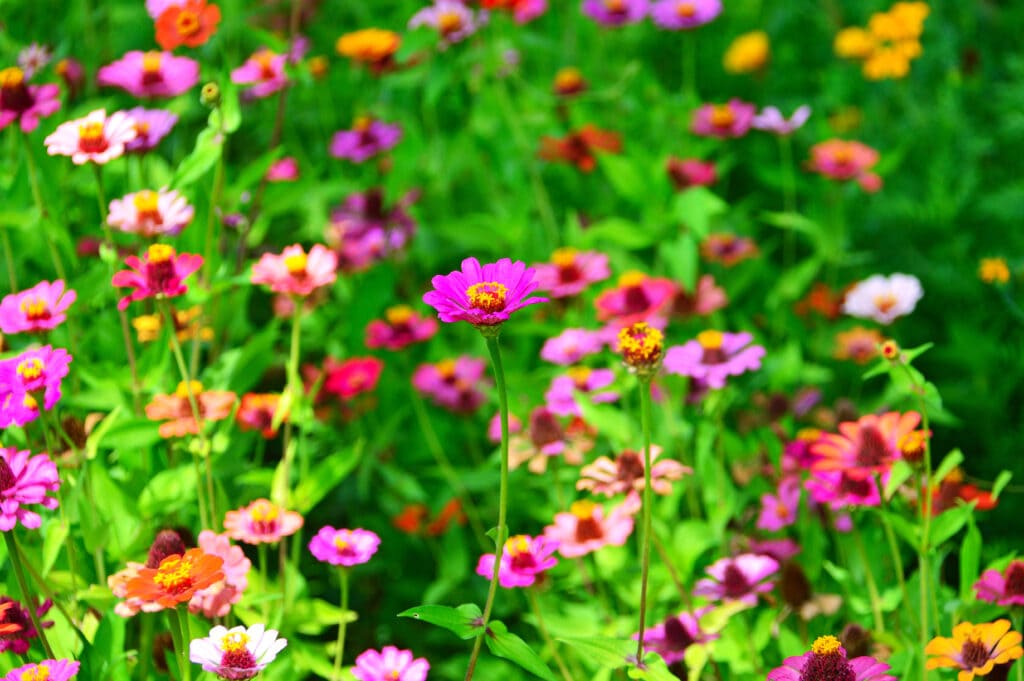
Exploring Alabama’s natural beauty is breathtaking. Far away from bustling cities, wildflowers thrive undisturbed. From birds-foot trefoil to bull thistle, the state has some of the most vibrant flowers in the country.
Read on below to find out more about some of the most beautiful wildflowers Alabama has to offer.

The 22 Wildflowers That Grow in Alabama
1. Chicory (Cichorium intybus)
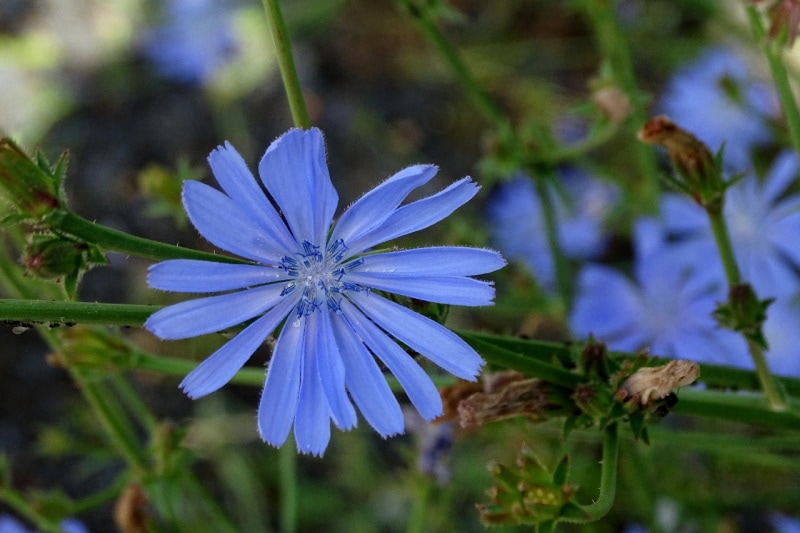
| Flower color: | Blue |
| Height: | 3 to 4 feet |
| Bloom Period: | Fall, Summer |
Chicory is a non-native wildflower found in all of Alabama, especially in disturbed, dry areas, such as old home sites, railroads, roadsides, pastures, and hay fields.
The plant is a member of the Asteraceae family and is classified as a herbaceous perennial. It is erect and can grow to a maximum height of 3 feet tall. Its leaves are oblong with a waxy texture, while its flowers are bright blue with a daisy-like shape.
One interesting fact about Chicory is that it has both cosmetic and medicinal properties. The leaves are rich in minerals and vitamins and can be consumed raw or cooked. Its roots can either be roasted, boiled, or eaten raw. Just be aware that this plant has a very bitter taste. Sometimes, roots can be ground and roasted as an additive and substitute for coffee.
2. Blue Vervain (Verbena hastata)
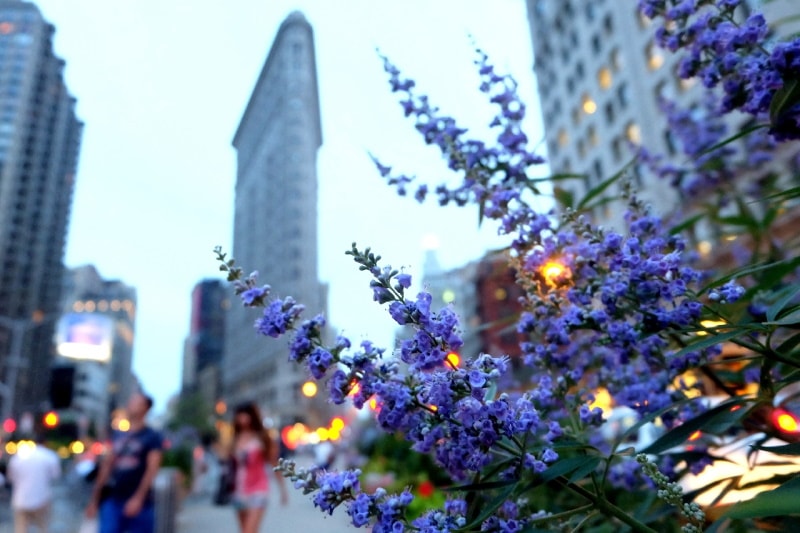
| Flower color: | Blue, Purple/Lavender |
| Height: | 2 to 5 feet |
| Bloom Period: | Summer |
Also known as Swamp Verbena or American Vervain, Blue vervain is a perennial wildflower native to Alabama and other parts of the United States. The plant belongs to the Verbena family and is distinguished by its tall, purple, or spiky blue flowers.
Blue vervain often thrives in moist or wet soil and is usually found near rivers, streams, and other water bodies. It blooms on a foot-long panicle in the early fall and late summer, and its blue and purple flowers attract pollinators for nectar, including bees, skippers, small butterflies, moths, and wasps. It’s also a great host plant because the Common Buckeye Butterfly and the Verbena Moth caterpillars eat the leaves.
3. Twisted Trillium (Trillium stamineum)
| Flower color: | Black, Purple/Lavender, Red/Burgundy |
| Height: | 12 to 15 inches |
| Bloom Period: | Spring |
Twisted trillium is a wildflower found in west-central Tennessee and the south and upper coastal plains of Alabama. The plant prefers rich woodland areas, such as hardwood forests, along creeks and streams, in prairie woods, and ravines.
Twisted trillium belongs to the lily family and can be distinguished by deep maroon, three-petaled flowers, and a foul odor for attracting beetles and flies. Petals are horizontal and have a distinct twist around the tips. Additionally, its stem is twisted, which gives it a unique, spiraled appearance.
4. Whorled Sunflower (Helianthus verticillatus)

| Flower color: | Yellow, Orange |
| Height: | 6 to 9 feet |
| Bloom Period: | Summer |
The tall sunflower was long believed to be extinct, but it was rediscovered in the 1990s in a tiny part of Alabama, West Tennessee, and Georgia. The plant is a member of the sunflower family and can be identified with enormous, bright yellow flower heads with 13 petals. It is a perennial with tuberous, thickened roots and slender rhizomes. Plants with slender stems can grow up to ten feet tall.
The Whorled sunflower blossoms between September to November and can often be found along roads and in pastures in the Coosa River Valley, including Cherokee and Etowah counties. In fact, in Cherokee county, whenever residents find them along the roads, the county puts up “don’t mow” signs to prevent workers from cutting them down.
5. Alabama Snow Wreath (Neviusia alabamensis)
| Flower color: | White |
| Height: | 3 to 6 feet |
| Bloom Period: | Spring |
The snow wreath is a wildflower and a member of the rose family. It includes three to eight bunches of unpetalled, 1-inch-wide white flowers.
The shrub grows fast and can reach heights of up to 6 feet. It’s known for its ability to tolerate various soil conditions, from average to medium, and well-drained soils. Plus, it is a low-maintenance plant that thrives in partial shade to full sun.
6. Fleshy-Fruit Gladecress (Leavenworthia crassa)
| Flower color: | White with yellow base, yellow with orange base |
| Height: | 3 to 15 inches |
| Bloom Period: | Spring |
Fleshy-fruit gladecress is a winter annual, spring-flowering member of the mustard family and native to Alabama. It is known for its tiny, white flowers and distinctive, fleshy fruit. The bloom’s center is yellow.
The plant can be found in open, sunny areas of forests in prairies and meadows. A good example of where to find this wildflower is in Indian Tomb Hollow, a biologically rich area of the Bankhead National Forest.
7. Alabama Canebrake Pitcher Plant (Sarracenia alabamensis)
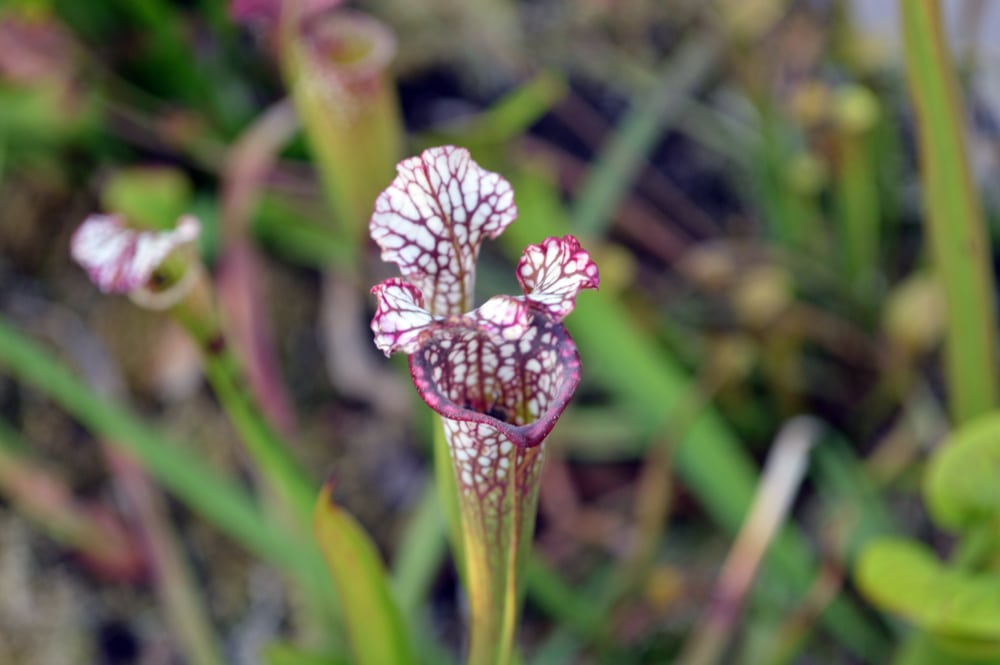
| Flower color: | Red/Burgundy |
| Height: | 12 to 18 inches |
| Bloom Period: | Spring |
The Alabama canebrake pitcher plant is a species of carnivorous plant native to the southeastern United States. Its main habitat is seepage bogs in Chilton and Autauga counties, Alabama. However, its range also extends into Florida, Georgia, and Mississippi.
The plant is a member of the genus Sarracenia and is characterized by a long, yellow-green tube with red veins that look much like an antique milk pitcher. The canebrake pitcher plant uses its modified leaves, and long, narrow pitchers, to trap insects that are attracted to the nectar inside the tube. The plant then releases enzymes that digest the trapped insects and provide the plant with nutrients, especially nitrogen.
Besides a long tube, the canebrake pitcher plant has beautiful, fragrant maroon flowers produced on tall stalks of up to two feet long in April and May.
8. Purple Loosestrife (Lythrum salicaria)
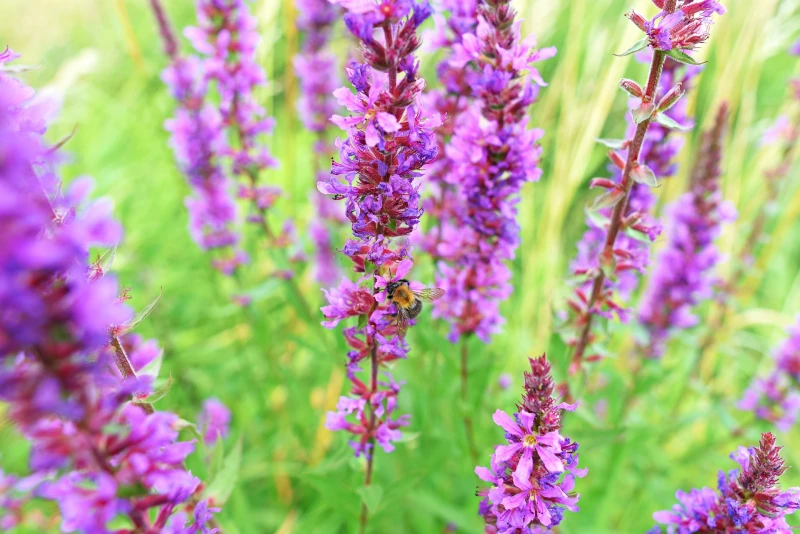
| Flower color: | Pink, Purple/Lavender |
| Height: | 2 feet to 6 feet |
| Bloom Period: | Summer |
Purple loosestrife is native to Alabama and abundant in most parts of the state. It is a perennial plant that grows up to 6 feet tall. It bears small reddish-purple flowers in small bunches along branches.
The plant usually grows in wet soil habitats, such as wet pastures, along lakes, and marshes.
9. French’s Shooting Star (Dodecatheon frenchii)
| Flower color: | White, Purple/Lavender |
| Height: | 12 to 18 inches |
| Bloom Period: | Spring |
You should travel to Tuscumbia and stop by the Cane Creek Canyon Nature Preserve if you are looking for uncommon wildflowers. The pathways down the canyon are blazing with color and various varieties of wildflowers, including the French’s shooting star.
The French’s shooting star is a perennial herb characterized by a stem of about 1–2 feet high that emerges from its rosette of green leaves. Each leaf is smooth and oblong. Flowers can either be pink, white, purple, or any combination of those colors.
10. Alabama Leather Flower (Clematis socialis)
| Flower color: | Blue-violet |
| Height: | 8 to 20 inches |
| Bloom Period: | Spring |
The Alabama leather flower is a plant that grows in only a few counties in the northeastern part of Alabama state—Cherokee, Calhoun, Blount, St. Clair, Jefferson, and Etowah.
It is a perennial vine in the buttercup family with the ability to grow up to 20 feet in length. The plant is known for its attractive leathery flowers that blossom in shades of purple and pink. Feather-like seed heads then appear and stick around throughout winter. Alabama leather flower tolerates drought once established and thrives in well-drained soils with partial to full light.
The ideal place to see this flower would be along the Coosa River Valley’s wet but sunny open areas. Try probing at the Nature Conservancy’s Gulf Creek Canyon Preserve and along Dry Creek in St. Clair County.
11. Creeping Charlie (Glechoma hederacea)
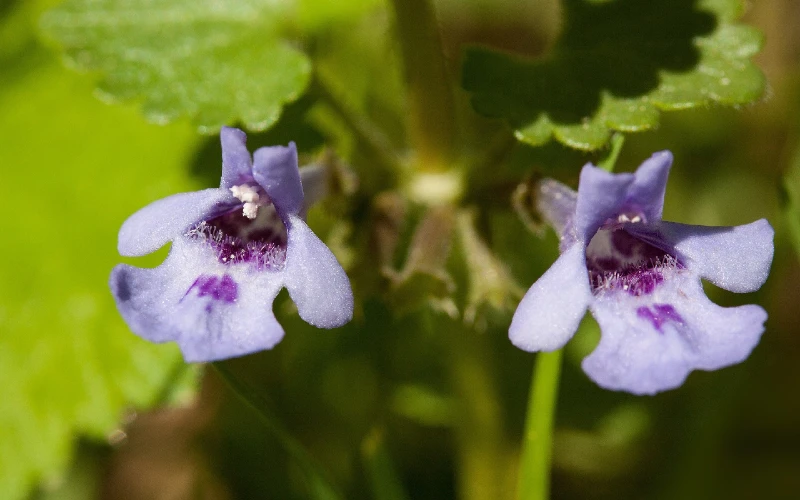
| Flower color: | Blue, Purple/Lavender |
| Height: | 1 foot or less |
| Bloom Period: | Spring, Summer |
Creeping Charlie is an herbaceous perennial plant that spreads via seeds and ground-climbing stems known as stolons.
It is set apart by bright green, kidney, or round-shaped leaves with scalloped edges, growing opposite to each other. The plant is commonly found in moist shady spots, such as alongside the north sides of buildings and under shrubs or trees.
12. Giant Ironweed (Vernonia gigantea)
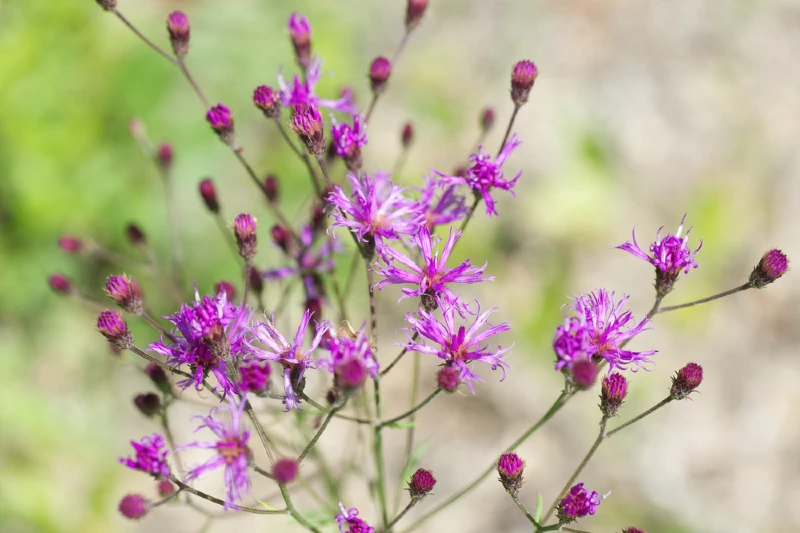
| Flower color: | Purple/Lavender |
| Height: | 3 to 12 feet |
| Bloom Period: | Late Summer and Fall |
Giant ironweed is a perennial plant found in Alabama and other areas of the southeastern United States. It is a member of the sunflower family and can be characterized by its large, iron-gray leaves and tall, purple flowers.
Giant ironweed grows up to 8 feet tall and produces a bunch of purple flowers during fall and summer. Flowers attract many pollinators, especially butterflies.
The plant can be found in moist, wooded areas and along roadside ditches and stream banks. It tolerates different types of soil and can thrive in both partial shade and sun. However, it does best in moist, well-drained soils.
13. Heal-All (Prunella vulgaris)
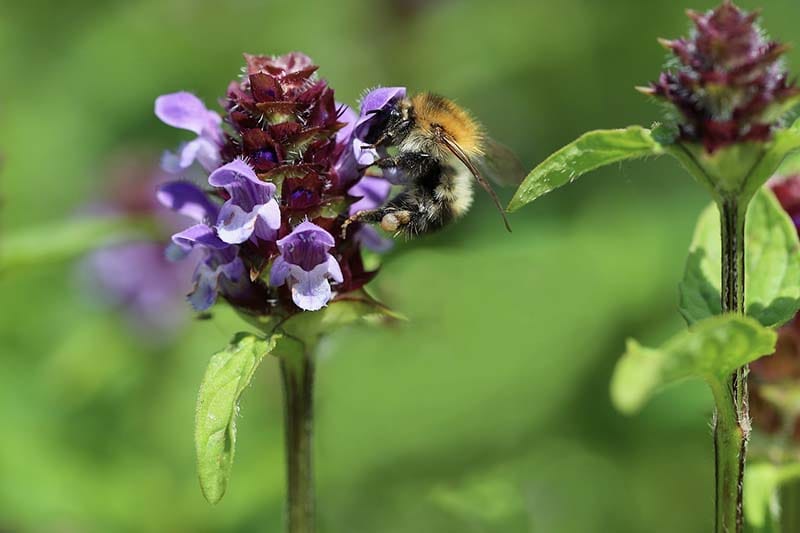
| Flower color: | Purple/Lavender, White |
| Height: | 0.5 to 1 foot |
| Bloom Period: | Fall, Spring, Summer |
Heal-All is a low-growing, herbaceous plant of the mint family and can be seen growing in a range of environments, including forest edges, meadows, and along roadsides. It measures about 15 to 30 centimeters in height and is best distinguished by its drawn-out terminal cluster of tiny blue-to-purple flowers. Its leaves are small, several, and densely arranged all through the flower cluster.
One of this plant’s most intriguing features is its ability to self-heal. If it gets cut or damaged, Heal-All will produce a sticky, white sap to help seal the wound and prevent further injury.
14. Crown Vetch (Securigera varia)
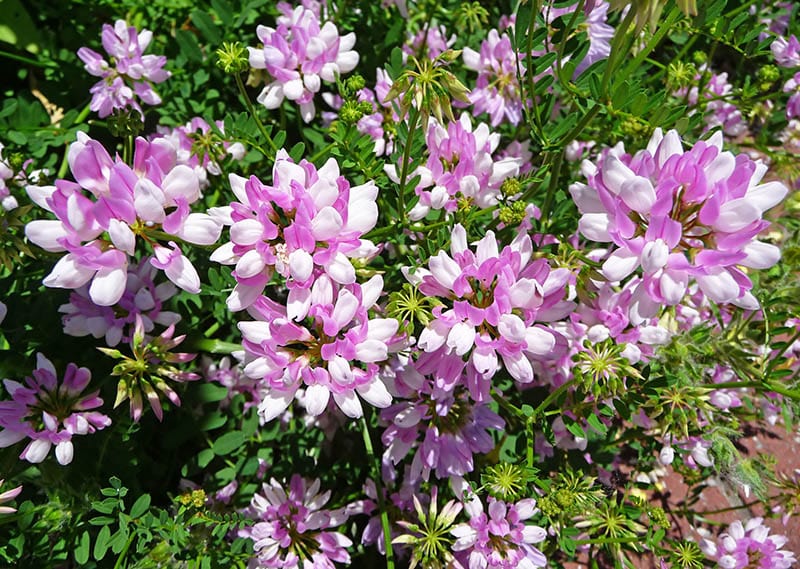
| Flower color: | Cream, Pink, Purple/Lavender, White |
| Height: | 1 to 3 feet |
| Bloom Period: | Fall, Summer |
This is an herbaceous vine that often forms thickets or sprawling mats up to 3 feet tall. It belongs to the same family as leguminous plants and can be identified by pinnate and alternate compound leaves with up to 25 pairs of leaflets. Flowers bloom during summer and come in a variety of colors, from pink to white or purple.
Crown vetch thrives in a wide range of soil conditions, such as rocky or dry soils, and is known for its ability to fix nitrogen in the soil. It’s often used in restoration and landscaping projects, especially on slopes or areas prone to erosion, and can be invasive in areas where it isn’t native. The plant can spread quickly and outcompete native plant species by smothering weeds.
15. Birds-Foot Trefoil (Lotus corniculatus)
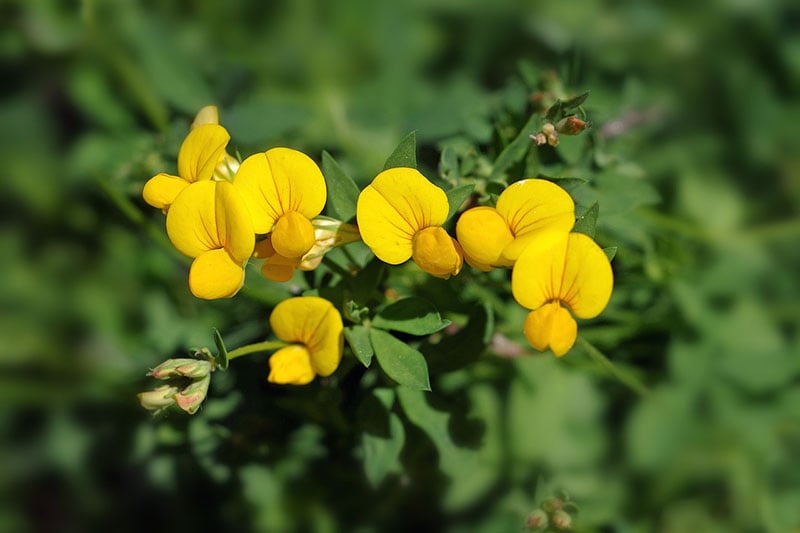
| Flower color: | Yellow |
| Height: | 2 to 8 inches |
| Bloom Period: | Summer, Early Fall |
Bird’s-foot trefoil is a flower belonging to the pea family native to grasslands and prairies of the USA and Canada. Many people identify the flower as a “beacon and egg” due to the unmistakable red and yellow color of the petals at the early blooming stage. In later stages of development, most parts of the petal turn yellow, which attracts insects and birds for pollination to form pods. The seed pods are arranged in a bird’s foot pattern hence its name.
This creeping plant survives mowing and extreme weather and many homeowners consider it a good garden plant. If you have an open garden that receives sunlight throughout the day, the bird’s foot will thrive well. It will grow up to 2 feet high, and blooming starts in mid-April all the way to September.
16. Dame’s Rocket (Hesperis matronalis)
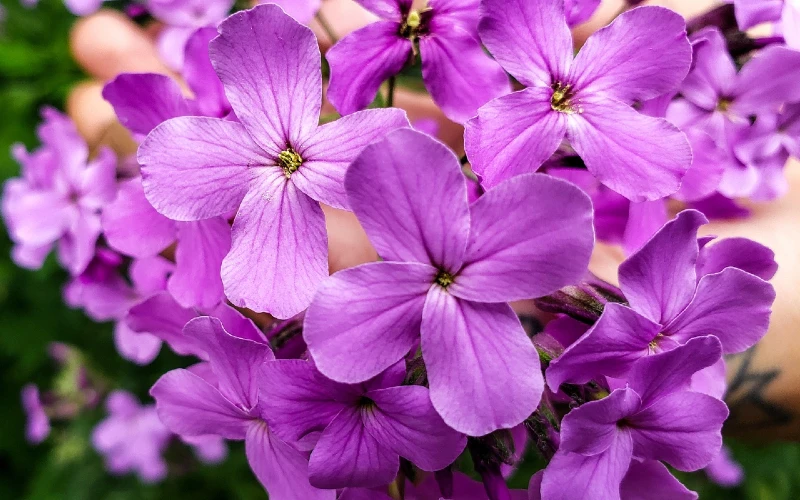
| Flower color: | Pink, Purple/Lavender, White |
| Height: | 1 to 3 feet |
| Bloom Period: | Spring |
Dame’s rocket is a wildflower introduced in North America in the 1600s from Europe. It is often sold in wildflower seed mixes and does well in moist, cool areas protected from the hot sun. In Alabama, it has naturalized itself in forests and around people’s gardens.
The flower is a biennial, meaning it has a 2-year life cycle like its family members, garlic and mustard. In the first year, dame’s rocket forms low rosettes of sharply pointed lance-shaped 2 to 6 inches long leaves, which remain green throughout the winter.
During the second year, the healthy leaves start photosynthesis in early spring to gather enough resources for bolting. Bolting is a horticultural term that explains the process by which plants form an elongated flower-bearing stem in an attempt to produce seeds.
Dame’s rocket bolts to form a 1.5 to 4 feet high stem to produce a cluster of four-petaled purple flowers between May and June. After flowering, the plant will produce thin back pods with hundreds of seeds to colonize other areas.
Being an invasive species, you should be careful when growing dame’s rocket. Scientific data shows that it causes monocultures by choking out native species. This reduces food for wild animals and the diversity of plants.
17. Bee Balm (Monarda fistulosa)
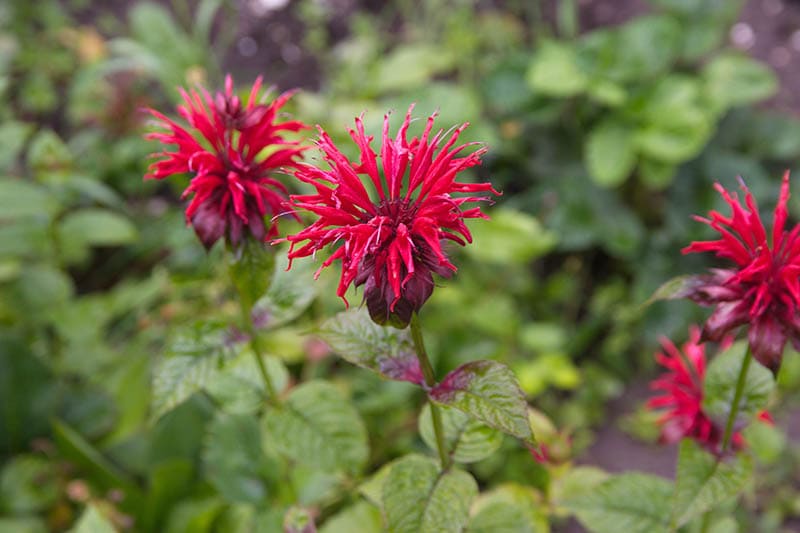
| Flower color: | Pink, Purple/Lavender |
| Height: | 2 to 4 feet |
| Bloom Period: | Fall, Summer |
Highly valued for their bright flowers and long blooming seasons, bee balms or bergamots are mint family plants endemic to Alabama and many parts of North America. At the end of each growing season, the plant bears slender tubular flowers on a 3-inch-wide flowering head. Of the more than 10 species in the bee balm, garden centers sell hybrid seeds and cultivars from only three; Monarda didyma, Monarda fistulosa, and Monarda puntata.
Depending on the species, they grow from 2–4 feet high and bloom in summer. The oval leaves are not particularly attractive but produce a soft fragrance reminiscent of the bergamot oranges they were named after.
18. Common Burdock (Arctium minus)

| Flower color: | Pink, Purple/Lavender |
| Height: | 1 to 5 feet |
| Bloom Period: | Fall, Summer |
The common burdock is a biennial weed under the genus of Arctium growing on a 6 feet tall hard stem. It has wide leaves that can grow up to 5 feet long and are supported by hollow stalks. Another distinguishing characteristic is the leaves are heart-shaped and wooly. Margins are slightly wavy and coarse, especially at the base, where leaves are the largest and toughest.
Purple flowers burst out at the end of branches, and the upper leaves’ axles on a quarter-inch thick stalks holding the flowerhead. The tubular florets are usually surrounded by hooked spines to attach themselves to fur and clothing.
If you intend to grow a common burdock, note that it spreads out quickly and hosts powdery mildew and root rot fungi which may devastate other plants. The wildflower is also poisonous, so handle it with care.
19. Bull Thistle (Cirsium vulgare)
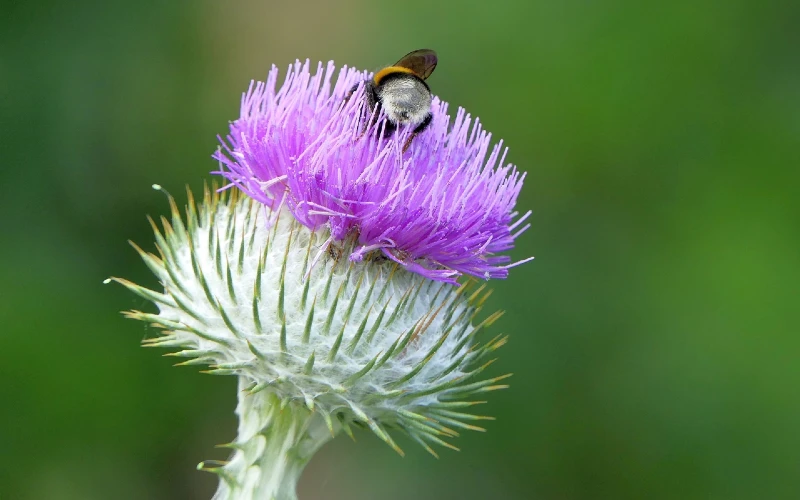
| Flower color: | Pink, Purple/Lavender |
| Height: | 2 to 5 feet |
| Bloom Period: | Summer |
Bull thistle is a wide-spreading biennial weed originating from Asia. Although its thorny stems and leaves are intimidating, it is not a problem for farmers. It mainly grows on empty pathways and along roads avoiding fields under continuous cultivation.
Being a biennial plant, the first year is for developing roots and leaves in preparation for bolting in the second growth phase. It produces 1 to 2-inch wide inflorescences (clusters of flowers) with pink and purple florets, which are similar in terms of size and are not divided into disks or rays.
Due to the spine-tipped leaves and stems, bull thistle is classified as an injurious or noxious plant in 9 states. Gardeners are thus advised to take safety precautions, such as wearing thorn-proof gloves when growing them.
Despite their appearance, bull thistle is beneficial to insects and birds. They are among the top nectar-producing plants attracting honeybees and hummingbirds. Mature seeds and seed pods are eaten and used as nesting material by goldfinches.
Some farmers are recognizing these benefits and are growing them along banks as part of a wide ecosystem that supports pollinators.
20. Bachelor’s Button (Centaurea cyanus)
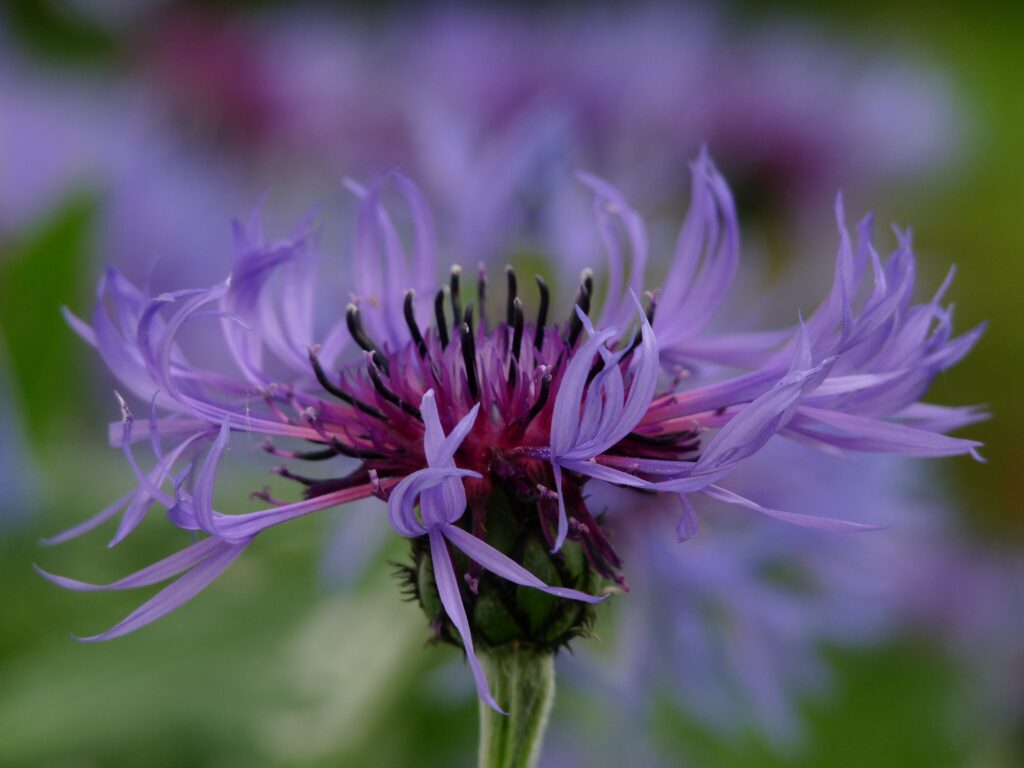
| Flower color: | Blue, Pink, Purple, White |
| Height: | 1 to 3 feet |
| Bloom Period: | Summer |
If you are from the corn-producing counties of Madison, Lauderdale, and Limestone, it is possible you have seen the bachelor’s button. The perennial plant is self-sowing, returning each year in full glory.
In fields grown with little use of herbicides, the plant matures to 3 feet blooming from late spring to the first frost.
Besides the cornflower blue, mature flowers come in shades of pink, purple, and white. The leaves, too, are appealing. They are long, slender, and silver-green, allowing them to mix perfectly with wildflowers. Away from beauty shows, the bachelor’s button is an edible flower. Mix it with salads to add color.
21. Red Buckeye (Aesculus pavia)
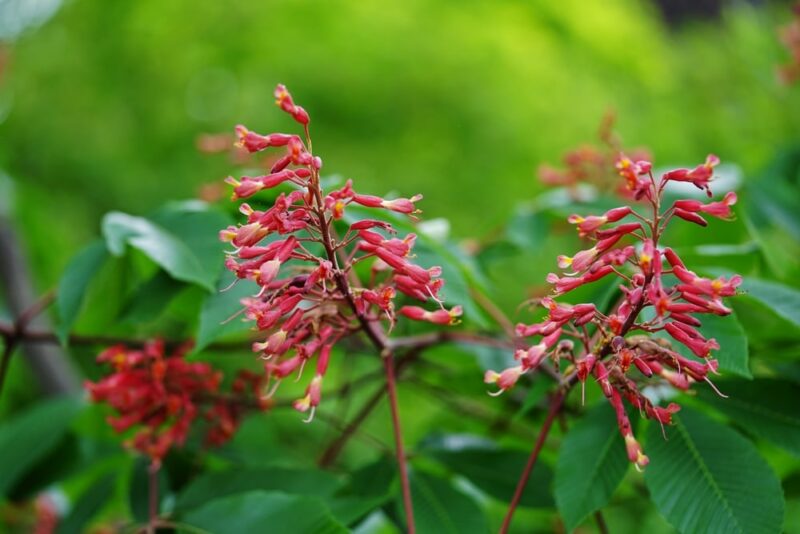
| Flower color: | Orange, Red/Burgundy |
| Height: | 15 to 25 feet |
| Bloom Period: | Spring |
Red buckeye is a species of deciduous shrub or small tree native to the southern part of the USA. This hardy plant has been cultivated closer to the arctic circle in Finland and is said to have extremely poisonous characteristics.
At the peak of its maturity, it stands 20 feet high and produces multiple stems and branches. The leaves are elliptical and serrated. It bears 4-inch long and tubular dark red or yellow hermaphrodite flowers every spring. With hybridization, you can find red buckeyes bearing both red and yellow flowers, a welcomed addition to large lawns.
22. Soapwort Gentian (Gentiana saponaria)
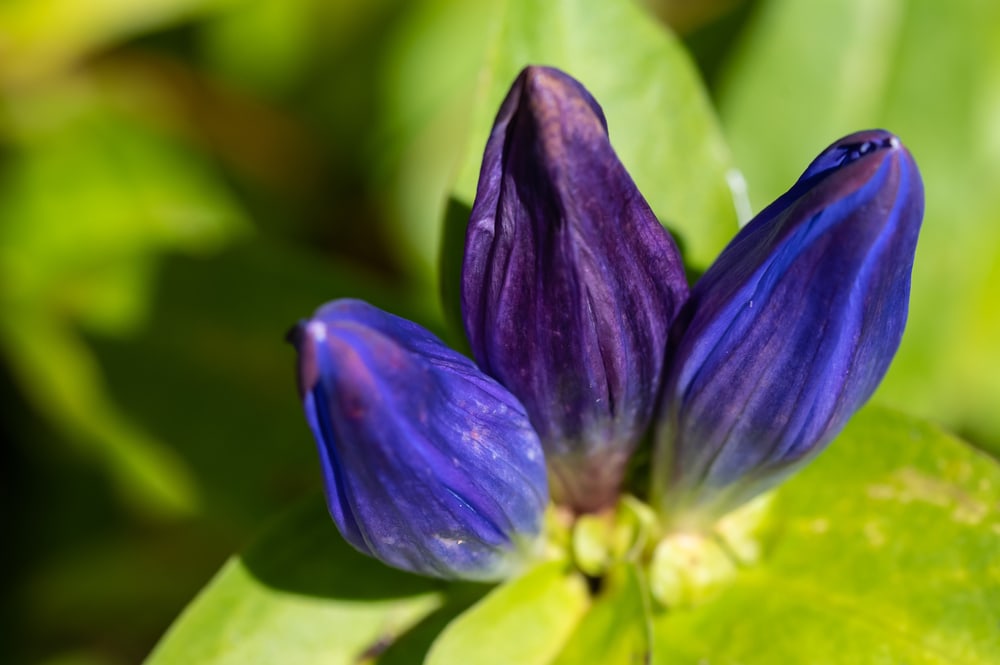
| Flower color: | Blue, Purple/Lavender |
| Height: | 1 to 2 feet |
| Bloom Period: | Fall |
Soapwort gentian is a small perennial plant that grows in open fields under full sun and sandy soils. The central stem is reddish and smooth. It does not have branches; instead, narrow and elliptic leaves grow opposite to each other on the stem.
One to six pale blue tubular flowers grow from the upper axils. Each flower has five lobes.
Though the plant will tolerate fertile soil, it needs to be well-aerated and drained. Introduce them to the garden as seedlings rather than sowing seeds directly. The plant roots faster and will take the shortest to bloom in the right conditions.

Conclusion
Alabama has an impressive collection of wildflowers. They do well in pasture fields, meadows, and ravines. Some flowers, like bachelor’s buttons, are edible, while others, like common burdock, are poisonous. But the good thing is you can plant almost all these wildflowers in your garden.
Featured Image Credit: JumpStory
Contents
